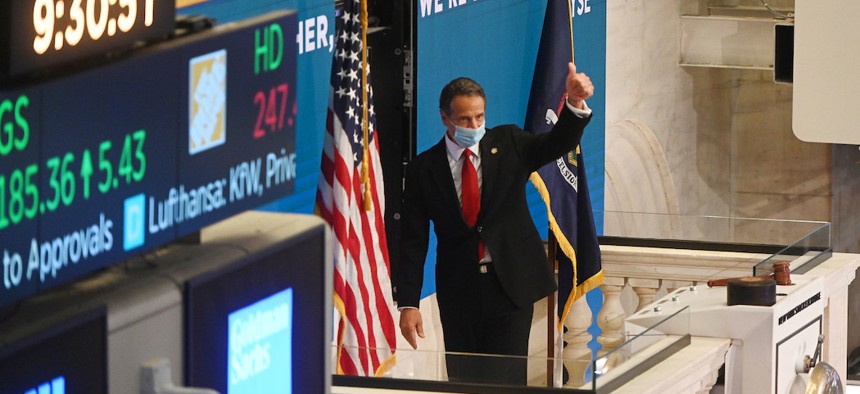When Gov. Andrew Cuomo signed the New York on Pause executive order on March 20, effectively shutting down the state, he made a declaration: “I accept full responsibility. If someone is unhappy, somebody wants to blame someone, people complain about someone, blame me.” On April 19, the governor reiterated his proclamation, telling New Yorkers that when it comes to the coronavirus crisis, the buck stops with him. “Blame me,” Cuomo said again. “Somebody's complaining about a beach, somebody's complaining about whatever, businesses open, schools open, blame me.”
But that hasn’t always been the case. Despite Cuomo asking for the blame for the potentially unpopular decisions made by the state in response to the pandemic, the governor has denied responsibility in several instances when faced with criticism. Here are a few times during the crisis when the governor laid the blame on someone or something else.
Nursing homes
The Cuomo administration has received intense scrutiny for its nursing home policies during the crisis. About 6,000 nursing home residents have died of COVID-19 in New York, around one-quarter of all the deaths in the state. In particular, critics have pointed to a March 25 directive that mandated nursing homes accept residents who test positive for COVID-19. The directive has been described by one lawmaker as a “fatal error.” But Cuomo has defended his policies on nursing homes and has said that the much-criticized March 25 Department of Health directive followed federal guidelines at the time. “They should ask President Trump,” Cuomo told reporters on May 20 when they pressed him on the policy. “Don’t criticize the state for following the president’s policies,” he reiterated on May 23.
Not acting fast enough
Cuomo has stood by the actions of his administration and the speed at which he moved to respond to the crisis given the available data at the time. But public health experts have said the coronavirus was circulating in New York well before the first documented case on March 1 and that the clock should have started in late January when the country saw its first case. Others have said that shutting down just one week earlier would have resulted in thousands of fewer deaths.
Cuomo has lamented not moving fast enough to curb the worst of the pandemic’s effects, but it also maintained it wasn't his fault. “Governor’s don’t do global pandemics,” Cuomo said on April 28, even though the state has a pandemic response plan and one of the responsibilities of the state Department of Health is to track emerging and infectious diseases in New York. He laid the blame on global health organizations and the news media for failing to “blow the bugle” in November and December. If only those groups and people had said something back then and made the impending threat clear, he could have acted sooner, Cuomo said.
The Chinese government only confirmed that it was treating dozens of cases of an unknown respiratory illness on December 31, and only identified the virus on January 8. The same month, the U.S. had its first case. On February 26, the country had its first instance of community spread, well after the president declared a public health emergency on January 31.
Budget cuts
The state is in a financial bind, facing a $10 billion shortfall this year alone. Despite the fiscal uncertainties the state faced at the beginning of April, Cuomo did not include large cuts or new revenue in the state budget he signed, instead promising to make rolling cuts as needed throughout the year. And he has done his best to lay the blame on the federal government for the potential cuts, which originally were slated to come out mid-May but which he has yet to release. The feds should bailout state governments, the governor said, so any cuts will be the result of their recalcitrance. “If they don’t act in a couple of weeks,” Cuomo said on May 19 of the federal government, “they will be more reckless and irresponsible than even I thought they were.” However, the governor has resisted calls to pass new taxes on the wealthy to prevent deepest cuts to schools and hospitals, which he has said is in the cards. And it’s he who is withholding crucial funding details from schools, leaving districts in a state of limbo as they attempt to craft their own budgets for the next year without knowing what they will get from the state.
Bad ventilator deal
When the state was scrambling to purchase more ventilators the Cuomo administration entered into an $86 million contract to purchase 1,450 ventilators from a man who had never sold medical equipment before. They paid him about $69 million upfront. But the ventilators never came. The man, Yaron Oren-Pines, came to the state’s attention when he replied to a tweet from President Donald Trump, saying that he had ventilators he was looking to sell. Despite the dubious nature of trusting a random man on Twitter to provide life-saving equipment, the Cuomo administration stood by the procurement decisions it made during the crisis. State officials claimed that the White House directly recommended Oren-Pines and that it had already vetted him, something the federal government denied. But when Oren-Pines attempted to sell millions of masks to the California government on the social networking site Nextdoor, users immediately could tell something was off. And when the federal government referred Oren-Pines to New Jersey officials, they decided not to enter into business with him because of troubling warning signs. New York did eventually get most of its money back, but officials arguably should never have entered into such a large contract with a man that even his neighbors could tell was a scammer.


